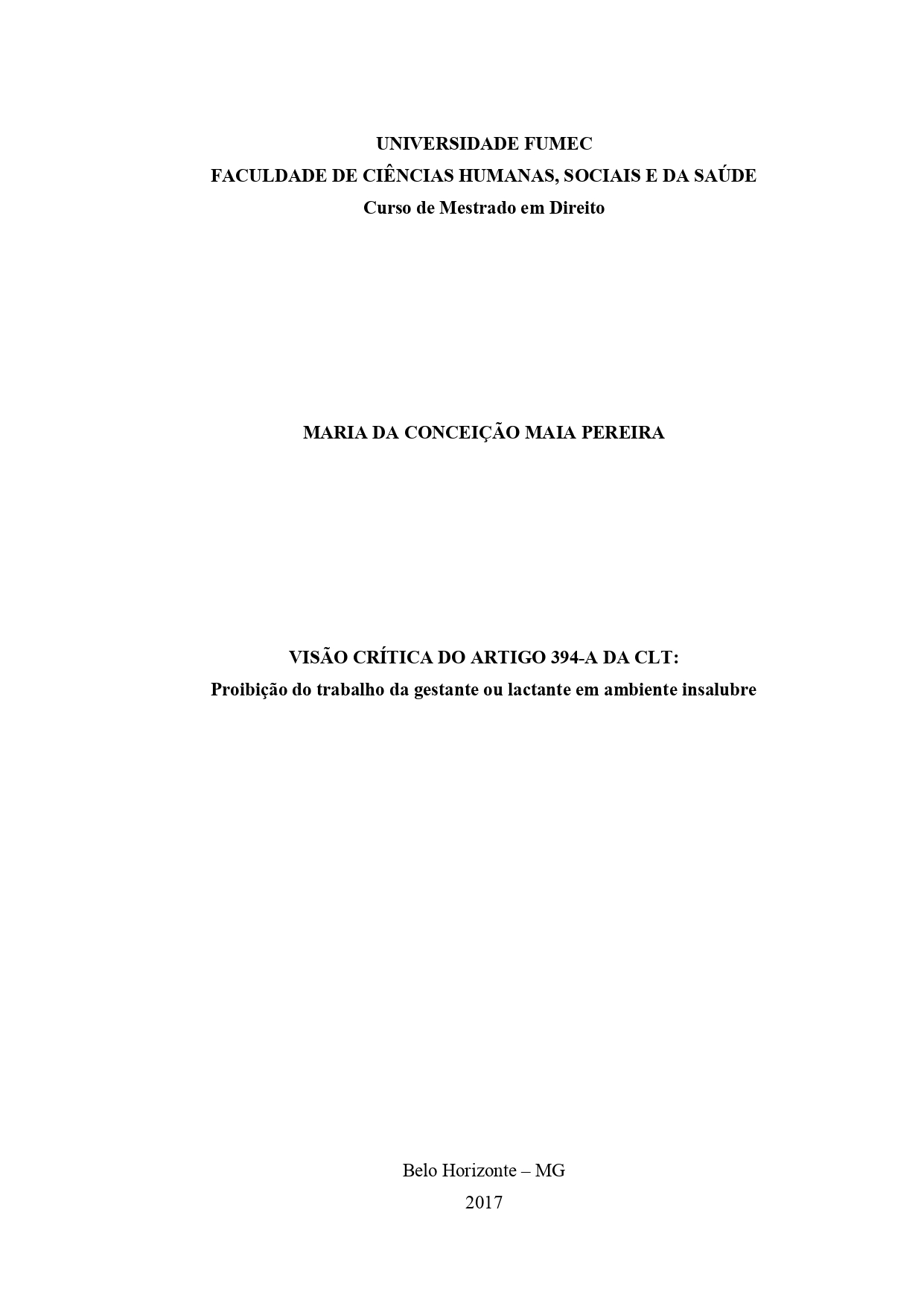Visão crítica do art. 394-A da CLT: proibição do trabalho da gestante ou lactante em ambiente insalubre

Visualizar/
Data
2017Autor
Pereira, Maria da Conceição Maia
xmlui.mirage2.itemSummaryView.MetaData
Mostrar registro completoResumo
O presente estudo se propõe a analisar o artigo 394-A, acrescentado à Consolidação das Leis
do Trabalho (CLT) por força da Lei 13.287/2016, que objetiva garantir proteção à
maternidade e à infância, direitos sociais previstos constitucionalmente, proibindo o labor da
empregada gestante ou lactante em ambiente insalubre, como forma de resguardar a vida, a
saúde e o bem-estar do ser concebido ou do recém-nascido. Para tanto, destaca-se que o
desempenho de atividades com exposição a agentes insalubres não é o único fator que pode
causar sérios danos à integridade física da trabalhadora grávida ou nutriz e, em consequência,
ao feto ou ao bebê. Também a execução de tarefas em condições de periculosidade representa
risco potencial à vida, circunstância não observada pelo legislador. Pontua-se, também, que
não basta a norma legal determinar o afastamento da empregada em estado gravídico de
quaisquer atividades, operações ou locais insalubres, sendo necessário levar em conta que, em
certos casos, não será possível ao empregador transferir a trabalhadora para desenvolver suas
funções laborais em ambiente saudável porque a empresa não dispõe de local com essa
característica, motivo pelo qual deverá ser concedida à empregada licença remunerada. Nesse
contexto, evidencia-se que o dispositivo legal não considerou tal possibilidade. No entanto, na
proposta de reforma trabalhista que o governo pretende aprovar, a redação do artigo 394-A
sofreu alteração justamente para determinar o pagamento de licença-maternidade quando
inexistir condição de remanejar a empregada grávida ou lactante para local salubre. Todavia,
os custos referentes à proteção à maternidade das trabalhadoras devem ser socializados para
evitar que o trabalho feminino sofra discriminação, cabendo ao legislador observar os
preceitos contidos na Convenção 103 da Organização Internacional do Trabalho (OIT), pacto
internacional ratificado pelo Brasil, para não repetir erros do passado. No aspecto, importa
enfatizar que nenhum benefício ou serviço da seguridade social poderá ser criado, majorado
ou estendido sem a correspondente fonte de custeio. Logo, ainda que se trate de simples
ampliação de benefício previdenciário, inexistindo norma legal estipulando os requisitos e
limites objetivos e subjetivos para a concessão de licença-maternidade na hipótese prevista no
artigo 394-A da CLT, impossível garantir tal benefício em condições que a lei não autoriza. The present study proposes to analyze the article 394-A, added to the Consolidação das Leis
do Trabalho (CLT, Consolidation of Labor Laws) by virtue of Law 13,287/2016, which aims
to guarantee maternity and child protection, social rights constitutionally provided,
prohibiting the work of the pregnant or lactating workers in an unhealthy environment, as a
way to protect the life, health and well-being of the conceived or newborn being. Therefore, it
should be noted that the performance of activities with exposure to unhealthy agents is not the
only factor that can cause serious damage to the physical integrity of the pregnant or lactating
worker and, consequently, of the fetus or the baby. Also the execution of tasks in dangerous
conditions represents a potential risk to life, a circumstance that was not observed by the
legislator. It is also noted that it is not enough the legal norm to determine the removal of the
pregnant employee from any unhealthy activities, operations or unhealthy places. It is
necessary to take into account that in certain cases it will not be possible for the employer to
transfer the employee to develop her work functions in a healthy environment, because the
company does not have a place with this characteristic, which is why the employee should be
granted paid leave. In this context, it is evident that the legal device did not consider such
possibility. However, in the proposal for a labor reform that the government intends to
approve, the writing of article 394-A has been modified precisely to determine the payment of
maternity leave when there is no condition to relocate the pregnant or lactating employee to a
safe place. However, the costs relative to the maternity protection of the workers must be
socialized in order to prevent female labor from being discriminated and it is up to the
legislator to observe the precepts of Convention 103 of the International Labour Organization
(ILO), an international pact ratified by Brazil, to prevent the repetition of the mistakes of the
past. In this regard, it should be emphasized that no social security benefit or service can be
created, increased or extended without the corresponding cost source. Therefore, even if it is a
simple extension of social security benefits, with no legal rule stipulating the requirements
and objective and subjective limits for the granting of maternity leave in the hypothesis
foreseen in article 394-A of the CLT, it is impossible to guarantee such benefit under
conditions that the Law does not authorize.
